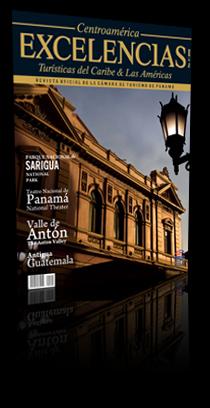Turismo IN THE Cros shairs
Mr. Campuzano, a man with a solid experience under his belt as general manager of the Panama Hotel and President of the local Tourism Chamber (CAPTUR), is by far a genuine connoisseur and promoter of tourism in both Panama and Central America. From his current post in Central America Tourism Chamber Federation (FEDECATUR), he speaks with Excelencias about some regional projects coming alive in the industry.
Is your appointment as President of FEDECATUR in any way related to your longstanding position in the industry?
The FEDECATUR presidency is a post that, according to the organization’s regulations and in an effort to guarantee equal participation among the seven member States in the region, rotates among the countries on an annual basis. This year is Panama’s turn.
How do you assess the Central America Travel Market (CATM), the Tourist Service Quality Program, the Central America Rural Inn Network and the Central America Tourist Entrepreneur Network?
Each of these projects hinges on a program of activities for both their follow-up and implementation. As to CATM, this year’s event will take place in Nicaragua, so FEDECATUR, through the Nicaragua Tourism Chamber and the country’s Tourism Ministry will be in charge of organizing the fair and making it happen.
As far as the Rural Inn Network is concerned, the first stage is now completed with the financial aid of the Support Program for Regional Integration in Central America (PAIRCA) by the hand of CEMPROMYPE. At the end of the day, we managed to piece together a pilot group of 50 inns all across Central America. With the ongoing making of the regional directory of rural inns we’re building on that follow-up support with the Spanish Cooperation Agency, the French Cooperation Agency, the UNWTO’s Sustainable Tourism Program for the Eradication of Poverty, and others. At the same time, the local tourism chambers are inserting some of those regional programs in their agendas, like the Tourist Service Quality Program, which is, as we speak, in a process of getting the teaching force ready through a postgraduation course at the Carlos III University in Madrid.
This course is due over in June, so those educators and trainers will later on help businesspeople who own micro, small and midsize travel companies to implement their own quality programs.
Within the framework of the Chamber Strengthening Plan and FEDECATUR, what actions have been taken in the short run?
In a first stage, we’re working in outlining and reviewing strategic plans of each and every chamber, as well as FEDECATUR’s own plan as the regional governing body. This will allow us to redirect the functions of our organizations in line with the needs and realities of today’s global travel industry. Based on that strategy, those actions will be followed by others, like defining the service portfolio the chambers offer to their members –of course, depending on an analysis of the overall and specific needs they have. How do you see CAMTUR’s position in the face of Panama’s new Tourism Act that will go into effect come August?
The Panama Tourism Chamber has played a major rolein the recent passage of the new Tourism Act and is having a hands-on engagement in the guidelines for that new legislation. A major step has been taken following the tapping of four key members and their corresponding substitutes on the part of CAM TUR for the New National Tourism Council. They will represent and stand up for the interests of Panamanian tourism’s private sector, as well as other modifications that will no doubt benefit all different sectors within the industry.
From your position as FEDECATUR President, what new commitments will you acquire now and what do they mean to CAMTUR? As President of FEDECATUR, the most important commitment is to continue strengthening the integration of Central America as a multi-destination travel choice, step up tourist arrivals in the region –especially from Europe- and reap far more benefits for the tourism private sector in Central America.















